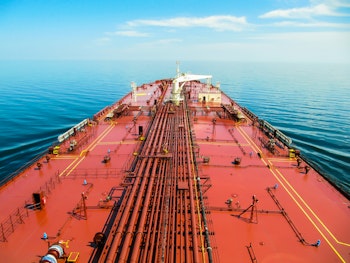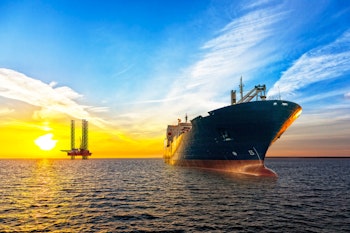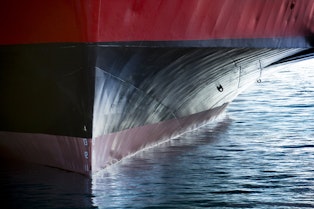Shipping faces a formidable problem in the race to cut carbon emissions in time to meet global climate targets. The industry is responsible for around 940 million tonnes of carbon dioxide a year, which is at least 2.5% of the world's total CO2 emissions.
Large vessels consume massive amounts of bunker fuel as they ply the seas around the world.
The good news is that vessel engines can handle oil that is less refined than is needed for other applications, so shipping’s per-liter emissions are lower than those of sectors that rely on energy-intensive refinery operations to turn crude into usable fuel.

The bad news is that bunker fuel still emits large amounts of carbon. And there are not many viable alternatives at present. One idea is to use hydrogen, which can be made without emissions when renewable electricity is passed through water.
This ‘green’ hydrogen may be carbon free, but it is also currently expensive and hard to move around. For use on ships, it needs to be stored at very low temperatures or very high pressures, neither of which is an attractive proposition for a safety-conscious ship’s captain.
Another option is to use this hydrogen to make green ammonia. Ammonia can be used as a fuel and is marginally easier to handle than hydrogen, but not much.
It is a gas at room temperature and so still needs to be cooled or pressurized, albeit not to the extent that hydrogen does. The problem is that turning green hydrogen to ammonia further increases the cost.
Furthermore, the use of ammonia in ship engine rooms is currently challenging due to the potential for leaks that might threaten the safety of the crew. This issue has not yet been satisfactorily addressed.
Finally there is methanol, which is a liquid at room temperature and can be used in dual-fuel engines with minimal changes to current vessel designs.
Methanol can also be made in a carbon-neutral way from green hydrogen combined with carbon that is captured from the atmosphere or from industrial processes.
However, the combination of green hydrogen production and carbon capture, both of which are expensive, likely makes methanol the costliest low-carbon fuel option of all, potentially putting it out of reach for all but a handful of premium applications.
There is, however, one other option that could help seemingly cut shipping’s emissions while alternative fuels are in development. That option is to carry on using bunker fuel as at present, but to trap the emissions using carbon capture and storage (CCS).
CCS is an established technology that is already used in sectors such as oil and gas. Although there are various ways of capturing carbon, one of the most commonly used methods is to pass exhaust gases through a carbon-binding filtration system.
This chemical absorption technology can be used to cut the emissions from power plants, industrial processes—and potentially large vessels.

Another process, called cryogenic separation, involves cooling exhaust gases to the point where carbon dioxide turns to liquid and can be separated out.
This approach is less technically mature than chemical absorption and research by Stena Bulk and the Oil and Gas Climate Initiative (OGCI) suggests the energy costs of refrigerating exhaust gases are so great that it is unlikely to be viable for shipping.
The question is: will chemical absorption work? The OGCI/Stena Bulk study looked to investigate this, using a Suezmax tanker as an example. The first point to be considered is that the carbon that is captured has to be liquified and stored somewhere.
To this end, the researchers assumed the vessel would be equipped with a liquefaction system and two storage tanks with 750 cubic meters of capacity each. The mass of the system was estimated to top 2,500 tonnes when fully loaded.
But the main challenge was energy consumption. Chemical absorption is more efficient at high temperatures and using just the waste heat from the vessel’s main propulsion engine would limit carbon capture rates to only around 8%.
“Achieving any level of carbon capture beyond this point would require additional heat sources coming primarily from the auxiliary engines and oil-fired boilers,” says the study.
The amount of energy needed to power CCS rises rapidly in line with the capture rate. Thus, it would take 22% more fuel to capture 50% of the carbon from the ship’s exhaust. To capture 90% of the carbon would require 53% more fuel.

As well as increased fuel costs, CCS is expensive for other reasons. Equipping a Suezmax to capture 50% of emissions would cost almost $13 million in components. And the equipment to get rid of 90% of carbon would cost nearly $19 million.
Adding in installation expenses and so on would take these figures to almost $21 million and $29 million, respectively. And operating expenses would be in the region of $975,000 and $1.9 million a year. That is before considering port-side infrastructure to offload the carbon.
In their conclusion, the researchers said there were no technical barriers to using CCS for marine vessel decarbonization. However, they added: “Although we demonstrated technical feasibility, capital and operating expenses remain high.
“Capex is driven by the relatively high costs of the storage tanks, compressors and columns, while the cost of excess fuel burned is the highest contributor to operating expenses.”
These costs “are a substantial hurdle to deployment and cost reductions in several key areas would be needed for the long-term viability of the technology,” added the authors.
Although it seems that CCS still has a long way to go before it is a commercially viable option for shipping decarbonization - it will be important one day. Bodies such as the International Energy Agency believe CCS will be critical in helping to reduce emissions across a range of hard-to-abate sectors where there is no immediate alternative to burning fossil fuels.
For now, companies wishing to reduce emissions may prefer to focus on tried-and-tested technologies such as sulfur scrubbers, which allow vessels to use less refined, and thus lower-carbon, bunker fuels.
What is clear though, is that scrubbers are vital for CCS anyway, since vessels that are able to capture carbon will still need to eliminate sulfur to comply with International Maritime Organization rules.
Scrubber technology can be deployed today and will start generating benefits immediately, whilst also forming the basis for future Carbon Capture developments.
Publish date: 15 December, 2022